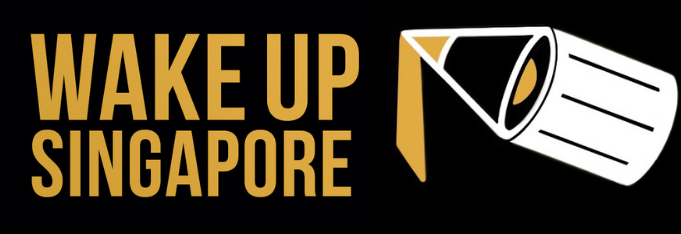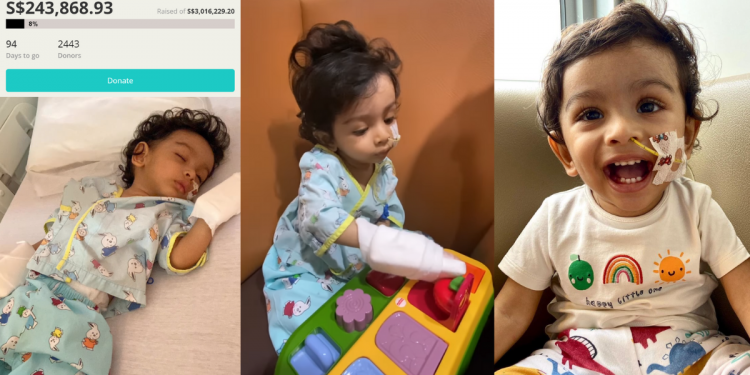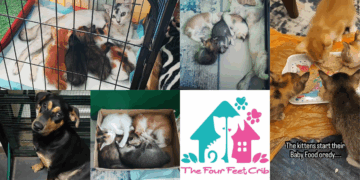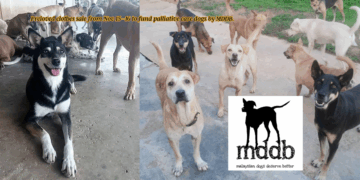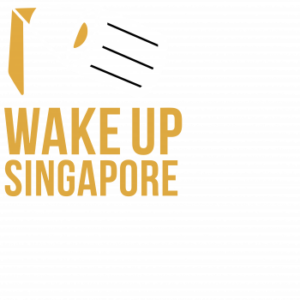On 15 November 2022, Baby Shamel, a 14-month-old warrior, was diagnosed with a rare condition known as type 2 Spinal Muscular Atrophy (SMA). SMA affects approximately 1 in every 10,000 babies.
His family are urgently looking to raise 3 million dollars for the world’s most expensive drug, Zolgensma, for Shamel to stand a fighting chance against this debilitating neuromuscular disorder. Zolgensma must be administered to Shamel before he turns 2.
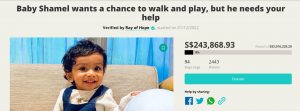
Symptoms leading to diagnosis
Shamel’s parents suspected that something was amiss when Shamel showed “signs of floppiness and low muscle tone”. After his first birthday, Shamel was not able to sit independently, crawl, stand, or bear weight on his legs. Soon after, he also lost the ability to kick.
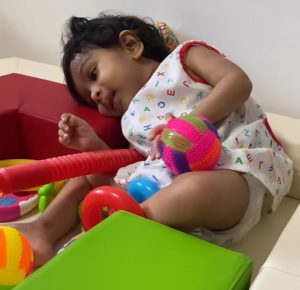
Shamel, who is the first and only child of the family, was fully alert and happy despite missing these motor milestones. However, he appeared to reject his food despite being hungry. Shamel’s parents now understand that he rejected food as he had difficulties swallowing due to SMA. As a result of this reduction in food intake, he also became thinner and weaker.
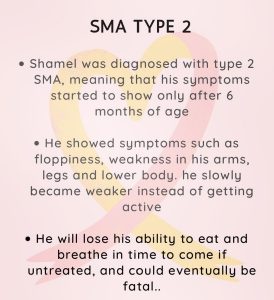
After some tests, doctors diagnosed Shamel with SMA.
SMA is potentially fatal
SMA is a disease that, if left untreated, may be potentially fatal for children especially as it makes them prone to respiratory infections and failures.
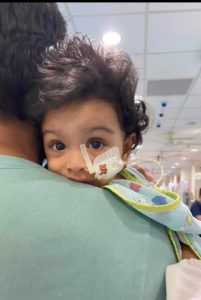
A week ago, Shamel was admitted to the hospital due to poor food intake. He had started choking on liquids and it was risky for him to continue being fed orally.
Doctors inserted a nasogastral tube to help Shamel receive the nutrition he needs. Being an inquisitive and active child, Shamel did try to pull at the tube initially.
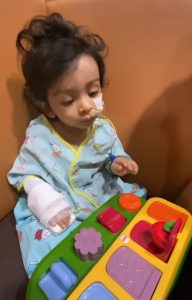
After a few days in the hospital, Shamel was discharged. Shamel’s parents shared that he was learning to live with the tube.
“It’s slightly unusual and upsetting when people look at Shamel twice and make certain comments because of a tube hanging from his nose! But we have learned to ignore the negativity and look at the bright side of nasal feeding. Shamel is benefiting from it which is all what matters to us as parents at the moment..
Nevertheless, he never forgets to smile and make us smile too. He teaches us what it means to be strong and gives us a reason to have hope for tomorrow!”
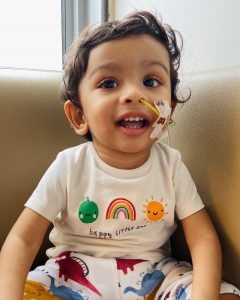
Zolgensma, the World’s Most Expensive Drug
Although there is no cure for SMA, the world’s most expensive drug, Zolgensma, may give Shamel a chance at living a normal life.
However, it is absolutely vital that he receives this one-time gene therapy as soon as possible before SMA causes further irreversible damage to Shamel’s nervous system.
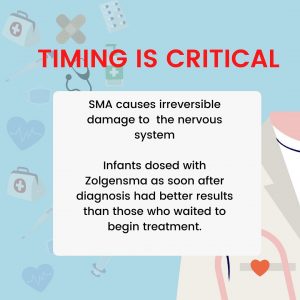
Put simply, Zolgensma helps by replacing the function of the missing or non-functioning Survival Motor Neurone (SMN1) gene.
Devdan, another baby who suffers from SMA and received Zolgensma in September 2021, is now making strides in relation to his motor skills and physiotherapy. It can and does give children afflicted by this rare disease a second chance at life.
Zolgensma costs approximately 3 million Singapore dollars due to the high costs of production and research involved.
A fundraising campaign to raise S$3M
Shamel hopes to follow in the footsteps of Devdan and Zayn – 2 babies suffering from SMA who successfully raised monies for Zolgensma.
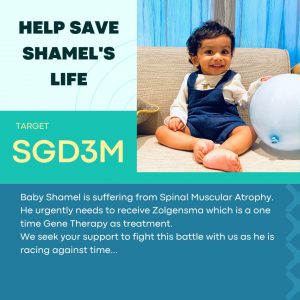
You may donate to Shamel’s fundraiser at this link – https://rayofhope.sg/campaign/baby-shamel/
As of 8.00pm on 26 December 2022, Shamel has raised approximately SGD 244,000, or 8% of the amount required for Zolgensma. The fundraisers have had sight of a Doctor’s memorandum which estimates the costs of the treatment to be SGD 3,016,229.20.
Ray of Hope, the platform hosting the fundraiser, does not take a cut from donations towards Shamel. In fact, Ray of Hope even covers the bank and credit card charges, which may amount to about 3% of the campaign target, so that 100% of all donations go directly to Shamel’s treatment.
To date, more than 2,400 donors have donated to Shamel’s campaign.
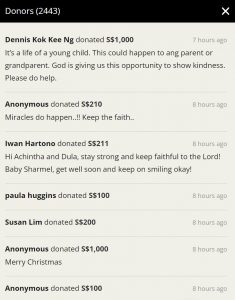
No amount is too small. If you can, please take a moment to donate to Shamel’s campaign.
You can also help by sharing the link to the fundraiser or this story with your friends and loved ones to encourage them to contribute as well.
2 previous fundraising campaigns for Zolgensma
When Baby Devdan successfully crowdfunded the amount needed to receive Zolgensma late last year, his parents called it a “miracle“. Devdan received Zolgensma just 1 week before his second birthday.
Earlier this year, when donations began running dry for Baby Zayn’s campaign to raise funds for Zolgensma, it was reported that an anonymous donor personally donated SGD 1.5 million dollars so that the child could receive the life-saving treatment that he needed.
While it is heartening that such fund-raising efforts have been successful, such efforts do rely solely on the goodwill of donors. When it comes to time-sensitive treatment like Zolgensma, which is more effective if it is administered earlier, the efficacy of fundraising efforts may pose an issue.
In situations like these, we submit that the well-being of a child should not depend only on the success of a fundraising campaign. In fact, this would be a perfect opportunity for us to utilise the Rare Disease Fund
What is the Rare Disease Fund?
The Rare Disease Fund (RDF) was set up in 2019 to provide financial support to Singaporeans who suffer from rare genetic diseases. Such patient usually need expensive medicine on a long-term or lifelong basis.
Donations to the RDF attract 3:1 Government matching, and enjoy tax deduction of 2.5 times the donation amount.
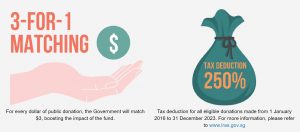
As of July 2022, the RDF has raised more than 137 million Singapore dollars. In November 2022, the Health Minister Ong Ye Kung revealed, in response to a question filed by Workers’ Party MP Leon Perera, that the RDF has supported 6 new patients since April 2021 and that there are “sufficient funds” to support these new patients.
The support for each beneficiary will be reviewed annually to account for changes in clinical condition and their financial situation.
In April 2021, in response to a previous question on the RDF also filed by WP MP Leon Perera, the Minister for Health explained how RDF applications are assessed, and how they may be made:-
Singaporeans undergoing treatment at public healthcare institutions can apply for assistance through medical social workers for medicines that are covered by the RDF’s support. Each RDF application is carefully assessed by an independent RDF Committee comprising members with diverse backgrounds from the community sector, private corporations, and healthcare. They consider various factors such as whether the patient is clinically eligible and therefore likely to benefit from the treatment, the family’s ability to afford the treatment either in part or in whole, as well as any extenuating circumstances faced by the patient and family. Beneficiaries are also expected to make a co-payment commensurate with the family’s means. To date, the RDF committee has received applications from eight patients and only one application was not supported as the cost of treatment was assessed to be within the family’s means.
Groups like the Rare Disorders Society (Singapore) (RDSS) and Rainbow Across Borders (RAB) have been helpful in raising awareness and providing support to patients with rare diseases. The RDSS and the RDF have collaborated in raising awareness about rare diseases as well as in fundraising.
Zolgensma is not a listed medicine in the RDF
RDF funds may only be disbursed to “listed” medicine. A drug may only be listed after the RDF Committee decides that the drug is able to “to meaningfully extend life expectancy and improve patient’s quality of life“.
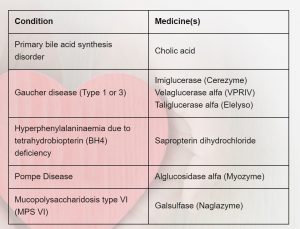
At present, RDF has only listed 7 medicines which treat 5 conditions. Unfortunately, neither SMA nor Zolgensma have been listed.
The Health Minister recognised that there are patients suffering from rare diseases who require expensive medicine that are non-listed. He also noted that some patients turn to crowdfunding to fun their healthcare expenses.
Should the Government step in to foot the bill?
We are of the view that the Government should step in, whether through the RDF or other means, to help Shamel receive Zolgensma that he urgently needs.
While we understand that Shamel and his family are not Singaporean, they have been in Singapore for a long time, and the fact remains that a child in Singapore requires high-cost and potentially life-saving medicine. So, we should allow the RDF or other funds to be disbursed in this case if possible.
This miraculous gene therapy that could save Shamel’s life should be administered to him as soon as possible, and it should not be left to the uncertainty of a crowdfunding campaign.
In Parliament, the Health Minister addressed the broader question of whether the Government should support the treatments regardless of their costs and efficacy:-
“This is a position that needs to be carefully reviewed and must not be taken lightly. For now, we will continue to monitor the situation and work towards expanding the scope of RDF treatments that can be supported. We also encourage members of the public to support the RDF with donations so that more medicines and conditions can be listed, and more patients can be supported.”
While it is commendable that the Health Ministry wishes to expand the scope of RDF treatments, it is unclear if such an expansion in scope would include Zolgensma. Further, it is unclear if such an expansion can be effected in a timely manner.
One possibility that may strike the right balance between the use of the RDF and crowdfunding would be for the RDF funds to be disbursed first to pay for Zolgensma as the treatment is time-sensitive. The crowdfunding campaign can then continue and be donated back to the RDF.
In relation to efficacy, the RDF Committee could look at the tremendous progress that Baby Devdan, Baby Axel (from Malaysia), and Baby Zayn have made after receiving Zolgensma in addition to reviewing the relevant literature and clinical trials from around the world.
We hope that the RDF Committee and the Ministry of Health can act swiftly to help Shamel and all other children afflicted with SMA in Singapore.
We as a people must do all that we can to ensure that babies like Shamel can continue to lead a meaningful and healthy life.
Petition to reduce price of Zolgensma
On a related note, more than 136,000 people have signed a petition for the price of Zolgensma to be reduced.
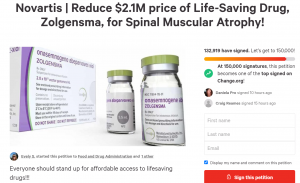
The petition notes that Zolgensma is simply priced out of reach for many suffering babies as delayed accurate diagnosis and treatment leave parents with little time to raise sufficient funds.
The petition argues that the price of Zolgensma should be tied to the safety and effectiveness of the drug:-
In May of 2021, Zolgensma entered the third year of being sold at the $2.1 million price tag, unlike any other sophisticated drugs for rare diseases.
Novartis AG, reduce the universal drug price of $2.1 million for Zolgensma by tying the safety and effectiveness of the drug to its pricing. Consider all generous incentives received by the F.D.A., not its fast-producing profit. Not only will that shorten the time of raising sufficient financial funds and assess the price of Zolgensma properly but will also save more babies! According to ICER, “Zolgensma’s price for Type I patients would need to be between $710,000-$1.5 million per treatment.” Once the price is reasonably reassessed, more countries will cover the treatment of Zolgensma ending ultimately the pain of afflicted families.
If you agree that life-saving medicine should not be priced exorbitantly, please sign the petition too.
More from Wake Up Singapore:
Since you have made it to the end of the article, follow Wake Up Singapore on Telegram!
